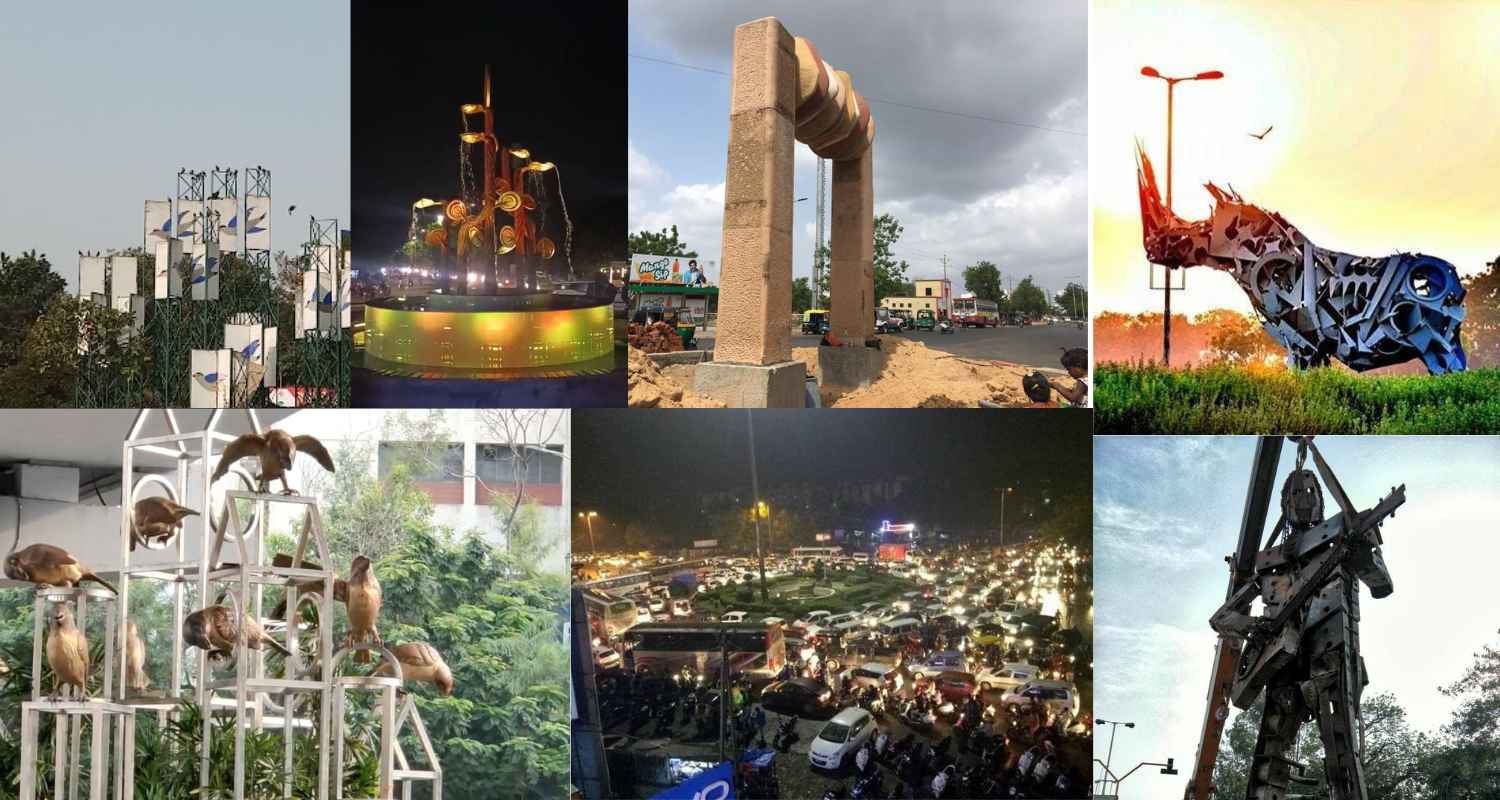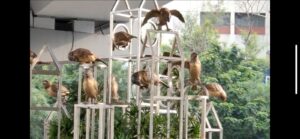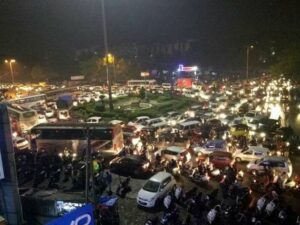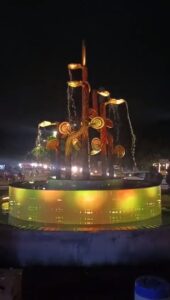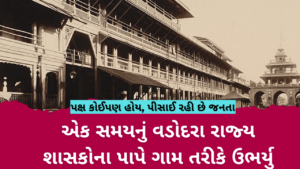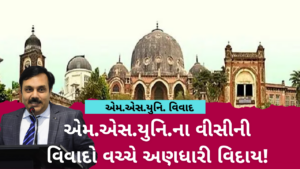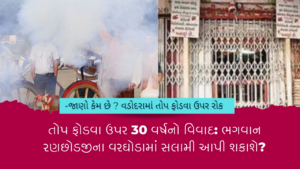–An Article By Poojan Patel
“All the Barodians, who have been staying here for quite a long time, can play the game of ‘Spot The Difference’ when it comes to the ‘development’ of the circles. Some of them have been transformed completely and some of them have to be shortened to resolve the traffic issue.”
In the heart of Baroda City, where history and modernity intersect, lie its iconic crossroads. These crossroads have long served as not just functional intersections but also as symbols of the city’s identity. However, recent changes made by the city have sparked a wave of both approval and discontent among its residents, leaving many to ponder the necessity of these transformations.
Baroda, also known as Vadodara, has a rich history steeped in culture and tradition. The city’s crossroads have always held a special place in the hearts of its people. They are adorned with sculptures and artworks that pay homage to the city’s heritage. These sculptures have served as silent storytellers, reflecting the vibrancy of Baroda’s past.
Change is a constant in the urban landscape, and Baroda is no exception. The city stands at a crossroads of its own, grappling with the tension between preserving its rich heritage and embracing the forces of modernization. As residents continue to voice their opinions and the city evolves, the crossroads of Baroda will remain a symbol of this ongoing dialogue between the past and the future. Whether the changes made by the city are ultimately deemed necessary or not, one thing is certain: Baroda’s identity will continue to evolve, reflecting the spirit of its people.
Chakli Circle
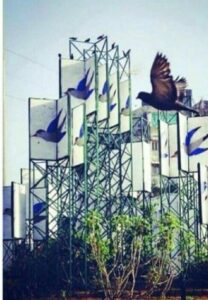
Nestled amidst the lush greens of Baroda (Vadodara) lies a place that once held a charming secret. The Chakli Circle, known for its vibrant blue art installation, was a testament to the city’s commitment to marrying art with nature. This masterpiece, which when viewed from any angle revealed the graceful form of a sparrow, was a beloved gem that captured the hearts of residents and visitors alike. The Chakli Circle installation, with its avian motif, was not merely a sculpture. Against the backdrop of verdant trees, the brilliant blue sparrow seemed to have alighted from the sky itself. Its presence was a source of delight, a visual oasis amidst the urban sprawl.
However, as progress often demands its sacrifices, the city management made the difficult decision to remove the beloved installation during the construction of the Atal Bridge. Many residents initially believed it to be a temporary measure, assuming that the sculpture would return to its rightful place once the bridge was completed. Little did they know that change was afoot, and Chakli Circle was set to undergo a profound transformation.
Upon the completion of the bridge, the city unveiled its vision for the new Chakli Circle. The new sculpture retained elements of the original concept, yet it marked a departure in design. No longer did a single sparrow grace the circle. Instead, a series of birds, almost trapped within a frame when viewed from afar, took center stage.
The transformation was met with mixed reactions. Some residents welcomed the change, seeing it as a fresh take on the beloved icon. Others clung to the memory of the solitary sparrow, feeling a sense of loss for its absence.
Rockstar Circle
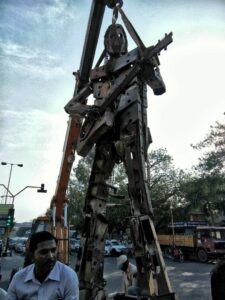 Recently, residents of Vadodara were met with a surprise on a Wednesday morning. The beloved Rockstar with a guitar sculpture, a fixture at the Diwalipura junction since its installation in 2017, had vanished from its usual spot. In its place, a city-based foundation had embarked on an ambitious project to beautify the circle with a theme close to the city’s heart—yoga.
Recently, residents of Vadodara were met with a surprise on a Wednesday morning. The beloved Rockstar with a guitar sculpture, a fixture at the Diwalipura junction since its installation in 2017, had vanished from its usual spot. In its place, a city-based foundation had embarked on an ambitious project to beautify the circle with a theme close to the city’s heart—yoga.
Officials from the Vadodara Municipal Corporation (VMC) confirmed that the Rockstar sculpture had been moved to the Harni sculpture park, making way for the transformative initiative at Diwalipura junction. This decision marked a significant shift in the city’s public art landscape, as Vadodara embraced a new vision of artistic expression and urban rejuvenation.
The Rockstar Circle was part of a collection of metal scrap sculptures that graced the city in 2017, adding a touch of artistic flair to its streets. However, the relocation of this iconic sculpture followed a critical assessment by Maharaja Sayajirao University Chancellor Shubhanginiraje Gaekwad. At the “Reimagining Vadodara” symposium held on May 1, Gaekwad voiced her concerns, referring to the metal scrap statues as “unaesthetic.” She lamented the replacement of beautiful installations that once represented Vadodara with these unappealing and unaesthetic metal scrap creations.
Genda Circle
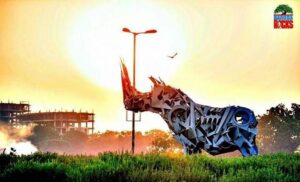 In the heart of Vadodara, nestled on the road to Vadodara Central, lies the iconic Genda Circle—a testament to the creative genius of Narottamdas Kavalya, also known as Narottam Luhar. This magnificent sculpture, which takes the form of a colossal rhinoceros, stands as a symbol of strength, aggressiveness, and brutal force, carved from the very iron scraps of the Sayaji Iron & Engineering Company Ltd. (SIECL) plant where it finds its origin.
In the heart of Vadodara, nestled on the road to Vadodara Central, lies the iconic Genda Circle—a testament to the creative genius of Narottamdas Kavalya, also known as Narottam Luhar. This magnificent sculpture, which takes the form of a colossal rhinoceros, stands as a symbol of strength, aggressiveness, and brutal force, carved from the very iron scraps of the Sayaji Iron & Engineering Company Ltd. (SIECL) plant where it finds its origin.
Commissioned in the 1970s by Indubhai Patel, the visionary founder of SIECL, the Genda Circle Rhino has become an integral part of Vadodara’s landscape and cultural heritage. The sheer size and weight of the sculpture, tipping the scales at nearly 3 tonnes, make it a captivating sight for both residents and visitors alike. The Genda Circle Rhino is more than just a piece of art; it represents the indomitable spirit of industrial prowess. Crafted from recycled iron scraps, this masterpiece is a living testament to Vadodara’s industrial heritage and its transformation into a thriving hub of innovation and progress. The Rhino’s powerful presence serves as a reminder of the city’s ability to harness raw materials and forge them into symbols of might and resilience.
The circle itself acquired its name, “Genda Circle,” from the Gujarati word for rhinoceros, “Genda.” It’s a fitting moniker, capturing the essence of the sculpture and allowing the people of Vadodara to connect with this majestic beast on a personal and cultural level.
Abacus Circle
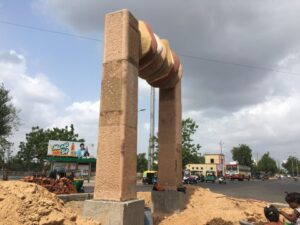 Formerly known as Akshar Chowk Circle, this distinctive sculpture, crafted by the skilled hands of Nagibhai Patel, found its original home on the road to Mujmahuda, leading to Padra Road. However, in 2014, without a clear explanation, it mysteriously disappeared from the urban canvas, leaving many puzzled.
Formerly known as Akshar Chowk Circle, this distinctive sculpture, crafted by the skilled hands of Nagibhai Patel, found its original home on the road to Mujmahuda, leading to Padra Road. However, in 2014, without a clear explanation, it mysteriously disappeared from the urban canvas, leaving many puzzled.
It wasn’t until 2017 that this remarkable sculpture reemerged, but with a new identity and location. Resurrected near the bustling Sama Crossroads, it quickly became a point of fascination and admiration for residents and passersby. This renaissance of art and culture was, in fact, the result of a commission by Transpek Silox Company, adding yet another layer to its story. The Abacus Circle derives its name from the resemblance it bears to the ancient arithmetic calculator, the abacus.
Sussen Circle
The centerpiece of this revitalized circle is a breathtaking tree-like sculpture that exudes a sense of serenity and wonder. Cascading from its intricately designed leaves, crystal-clear water flows gracefully, catching the shimmering light of thoughtfully placed fixtures. When the sun sets, and the lights are switched on, the circle transforms into a spectacle of colors, casting a spell of enchantment upon all who pass by.
This water art installation, with its elegant combination of nature and technology, has not only breathed new life into the circle but has also become a source of pride for Vadodara’s residents. It stands as a testament to the city’s commitment to creating spaces that blend art, nature, and innovation.

